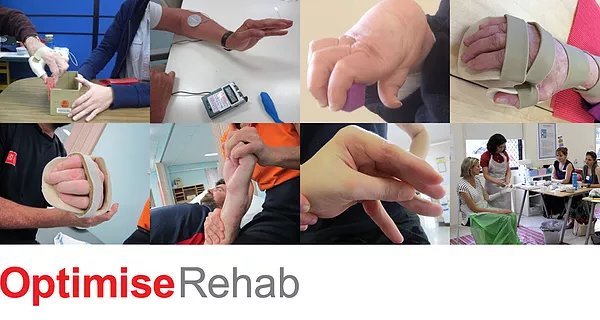
OptimiseRehab
Call: (07) 3217 3219
Email: admin@optimiserehab.com.au
Website: www.optimiserehab.com.au
Facebook: optimiserehab
Address: Unit 1 / 6 Broadway Street, Wooloongabba
Neurorehabilitation at OptimiseRehab
Treatment Plan customised to your injury or condition
An injury or a condition affecting the brain and nervous system can be a life-changing event. This is why neurorehabilitation is important to OptimiseRehab: neuro meaning the brain and nervous system and rehabilitation meaning after the injury or condition has occurred.
Upper limb neurorehabilitation
At OptimiseRehab the primary focus is on upper limb neurorehabilitation, this type of rehabilitation assists clients with regaining movement and function in their hands, arms and shoulders. The team of OptimiseRehab work with children and adults and specialise in assessing and treating the impact of a nervous system condition (such as a stroke) or an acquired brain injury on practical self-care and daily living tasks.
Assessment and treatment
The assessment and treatment OptimiseRehab provide can assist with physical skills which require the use of the hands, arms and shoulders such as using a knife and fork, pushing the lawnmower, using the computer, dressing, hand-writing, and daily hygiene. Additionally, Optimise Rehab provide clients help with their cognitive skills for example thinking, organising and remembering and with their emotional adjustment to the condition or injury.
Improved hand, arm and shoulder function are possible
OptimiseRehab’s commitment to our clients is to provide them with hope – hope that improved hand, arm and shoulder movement and function are possible; treatment, therapy and advice is tailored to what will work best for clients.
Strokes, acquired brain injury and cerebral palsy
OptimiseRehab has worked with a wide range of clients such as those who have suffered strokes (adults who have had a stroke relatively young in their 40’s through to older adults who have suffered strokes in their 60’s and 70’s); those who have had a motor bike or car accident (often this is young men in their late teens to early 30’s who have had this happen) and young adults with cerebral palsy (there are a number of children’s services available – but due to lack of public funding, young cerebral palsy adults often find once they reach adulthood there is not the same attention given to their rehabilitation; this is where Optimise Rehab can help).
Treatment Plans are tailored to a client’s injury or condition
OptimiseRehab’s guarantee is to provide a Treatment Plan that is tailored to the client’s injury or condition; because one type of intervention does not suit all. Often clients need a range of interventions depending whether it is their arms that have been severely affected or whether they have no hand function or whether they may only have shoulder or elbow movement; all these things need to be taken into consideration.
The timeframe of the Treatment Plan is also variable – some clients come in once a week for a year or more while other clients may have more intensive therapy such as 4 sessions a week over a month. OptimiseRehab works with clients at their own pace, providing personalised therapy that supports them to reach their own movement goals.
OptimiseRehab is an approved provider for the Department of Veterans Affairs (DVA), WorkCover, Medicare Extended Primary Care (EPC) and private health funders.
Go to the Optimise Rehab website for more information.
SERVICES OVERVIEW:
-
Group learning (e.g. classes such us LIMBer UP and SaeboFlex)
-
Independent learning (e.g. using work stations or circuit classes)
-
Working alongside, and observing, a ‘practice partner’
-
Repetitive practice
-
Practicing a range of different function skills within a session
-
Practice focused on individual goals and real tasks (e.g. independently cooking a meal)
-
Practicing a whole task sequence (e.g chopping vegetables), as well as the different parts of the task (e.g. holding the knife)
-
Functional electrical stimulation (FES), also known as Electrical Muscle Stimulation (EMS) or Neuromuscular Electrical Stimulation (NMES). This is a technique that uses electrical currents to activate nerves affected by paralysis resulting from a neurological disorder, condition or acquired head injury
-
Computer-based movement games
-
Robotic or mechanical devices that assist with movement and function – for example Tailwind device that repetitive guides arm movement along a track.
-
Bilateral (that is, two-handed) movement with/without rhythmic sound prompting (for example, moving in rhythm to a metronome, musical beat or verbal prompt)
-
Constraint-Induced Movement Therapy (CIMT) and modified Constraint- Induced Movement Therapy (mCIMT). This type of therapy improves upper extremity function in stroke and other central nervous system damage victims by increasing the use of their affected upper limb.
-
Watching videos of target movements – showing movement that the client has a goal of being able to do.
-
Visual Imagery techniques – the mental practice of tasks to retrain the brain (in other words, the promotion of neuroplasticity), imagining of a task without the physical execution but creating a working memory.
-
Mirror therapy – this involves the use of a mirror to create a reflective illusion of an affected limb in order to trick the brain into thinking movement has occurred without pain.
